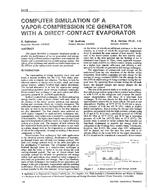A new method for optimizing the indoor thermal climate under nonuniform temperature distribution by accounting for energy conservation and indoor thermal comfort has been developed. Temperature settings and arrangements of thermal sensors of an HVAC system are optimized using a genetic algorithm-based method (e.g., Cantu-Paz 2000). In a genetic algorithm, design variables are coded into a “chromosome†that is subject to a series of genetic operations in search of an optimized solution. An optimal sensor arrangement requires (1) the air temperature at the sensor location to correlate well with the thermal comfort of occupants regardless of seasonal and load variations and (2) low energy consumption to be maintained while preserving thermal comfort with an adequate temperature setting. Using an index called the contribution ratio of indoor climate (CRI), the results obtained for an optimized sensor arrangement and temperature settings are presented and compared with the results of alternative arrangements.
Units: SI
Citation: ASHRAE Transactions, vol. 112, pt. 1
Product Details
- Published:
- 2006
- Number of Pages:
- 12
- File Size:
- 1 file , 8.2 MB
- Product Code(s):
- D-27982


